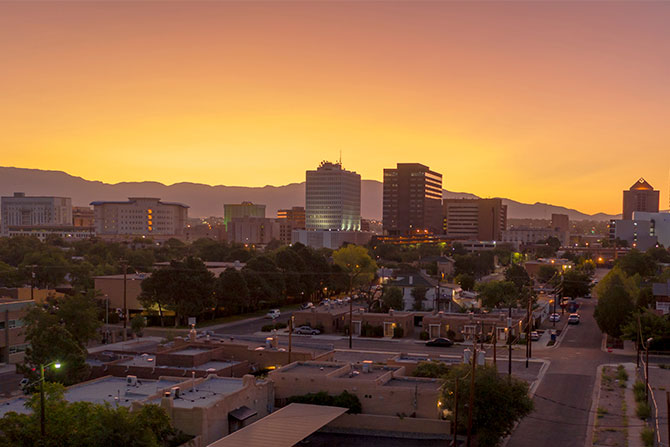As you may know, the NMBA recently moved to a new office at 7801 Academy Rd. NE, Bldg. 2, Ste. 202, Albuquerque, NM 87109. We had leased our former office space for 20 years and accumulated an incredible amount of paper, files and memorabilia over the years. Overall, it’s been nice to get a bit of a fresh start.
Sunwest Bank
While going through articles I have saved, there was one in particular that caught my eye. It was concerning the conversion of Albuquerque National Bank to Sunwest Bank of Albuquerque. I love history, so I thought I would share some of the highlights of the article, if for no other reason than it demonstrates how profoundly times have changed.
In 1983, Albuquerque National Bank, the state’s largest bank for 50 years, became Sunwest Bank of Albuquerque. With $1.7 billion in assets, Sunwest was double the size of its nearest competitor, First Interstate Bancorp.
The following appeared in a 1983 Albuquerque Journal news article:
William “Bing” Grady, president of the bank, admits that he and his team of top executives have been looking over their shoulders of late at the pack of pretenders to the throne of state banking. Loosed from the bonds of regulation and lobbying hard for still more freedom to introduce new packages of financial services and interstate banking, feisty brokers and thrifts throughout the country are knocking banks off at the rate of one a week. “Our competitors are going to be strong,” acknowledges Grady.
Still, Sunwest has been a leader in service throughout the state. It was the state’s first mortgage lender, the first to issue credit cards, and the state’s leader in electronic banking. It’s Mesa Grande bank-card center — the state’s only processing center — makes and embosses credit cards, authorizes credit on a 24-hour basis, and processes Visa and Mastercard for 45 banks, 6,500 merchants and 185,000 cardholders. “This community doesn’t like change,” said Grady. “The good old boy days may be gone, but when a customer walks in the door, he likes to know that he’s going to see the same faces.”
As of 1983, Sunwest held 25% of deposits in Albuquerque, First National Bank held 15.2%, First Interstate Bank held 7.7%, First City National Bank held 4.4%, Albuquerque Federal held 17.1%, Sandia Federal held 11.0% and all other banks held 20%.
Of course, Sunwest is now Bank of America, the second largest bank in Albuquerque by deposit size with $5.51 billion in deposits as of June 30, 2024, and a 12.6% market share.
One Big Beautiful Bill (OBBB)
My comments concerning OBBB, which was signed into law on July 4 and contains 870 pages, are intended to discuss certain subjects covered in that bill and do not reflect in any way my personal opinions or the opinions of other individuals related to the NMBA. Our intent is to simply report the facts.
Business Provisions
ACRE Act: OBBB includes a narrow version of the Access to Credit for Our Rural Economy Act of 2025 (ACRE). The act permits a qualified lender to exclude from gross income 25% of interest income derived from certain qualified real estate loans to include any loan secured by rural agriculture real estate such as any real property which is substantially used for the production of one or more agricultural products, any real property which is substantially used for the trade or business of fishing or seafood processing, and any aquaculture facility.
Section 199A Pass-Through Deduction: The OBBB maintains the current Section 199A pass-through deduction rate of 20% and makes it permanent.
Qualified Business Income Deduction: Noncorporate taxpayers who held interests in certain partnerships and other pass-through entities, including real estate investment trusts (REITs), are allowed a 20% deduction for domestic business profits (the section 199A deduction).
Remittance Transfers: OBBB imposes a remittance tax of 1% payable by the sender of cash and cash equivalents to recipients outside the United States. Transfer provider must collect the remittance tax and has secondary liability if the tax is not collected. There are exceptions for transfers funded with a U.S. debit or credit card or from an account held with certain financial institutions.
Estate and Gift Tax Exemption: OBBB permanently increased the estate and gift tax exemption to $15 million per individual, with inflation adjustment after 2025.
Individual Income Tax Rates Under Tax Cuts and Jobs Act: OBBB makes the 37% top marginal rate permanent.
State and Local Tax (SALT) Deduction Cap: OBBB increases the cap to $40,000 for 2025, with an annual increase of 1% per year through 2029. The cap is reduced to $10,000 for those with income above $600,000 (with annual 1% increases to this income threshold).
Excise Tax on Investment Income of Private Universities: OBBB creates a tiered system with three rate brackets ranging from 1.4% to 8% based on the size of the institution’s endowment (determined on a per-student basis). This applies to taxable years beginning after December 31, 2025.
Health Care Provisions: Health care analysts have commented that every state’s health care system will be adversely affected by the OBBB in a multitude of ways, and New Mexico, being a poor state heavily dependent on government assistance, may feel the effects more acutely than most. Based on most recent estimates, New Mexico stands to lose $2.8 billion in Medicaid funding and at least $224 million in cuts to SNAP benefits (food stamps). As a result, it’s estimated that 88,000 New Mexicans will lose Medicaid coverage while about 58,000 will likely lose SNAP benefits. The New Mexico Health Care Authority (HCA) also estimates that at least six rural hospitals may close, and jobs may drop by 2% across the state. According to Kari Armijo, cabinet secretary for the Health Care Authority, facilities in Gallup, Las Vegas, Taos and Union County are those currently at the highest risk for closure.
The nonpartisan Congressional Budget Office has found the legislation is set to strip nearly $700 billion in Medicaid and $267 billion in SNAP funding by 2034, while increasing the number of Americans without health insurance by 16 million. It’s going to hit New Mexico particularly hard in both of these areas, as nearly 40% of our state’s population is on Medicaid and 23% enrolled in SNAP. According to the HCA, New Mexico stands to lose more than a quarter of its annual Medicaid funding, a large percentage of which would have supported reimbursement to health care providers. The outlook for SNAP is similarly bleak, with the state estimated to lose anywhere in the range of $224 million to $352 million in the first year alone.
However, analysts believe that these numbers alone don’t paint the full picture of how dire the situation truly is. The budget bill also imposes new community engagement and work requirements for Medicaid and SNAP recipients, requirements the HCA said would create additional red tape and mountains of paperwork for the 254,000 Medicaid enrollees in New Mexico and the 175,979 SNAP recipients in the state.
Cuts aren’t just limited to New Mexico’s Medicaid program, but are set to massively affect the state’s hospitals and BeWell, the state’s health insurance marketplace. Sara Fitzgerald, director of policy and compliance at BeWell, said the bill will create narrower eligibility requirements and more obstacles to enrollment while also driving up health insurance premiums. “Ultimately, that makes it harder to get coverage, harder to keep coverage and harder to afford coverage, which at the end of the day spells decreased coverage,” Fitzgerald said.
Every analysis of the legislation, including that of state officials, suggests that it may well make life for the average American much more difficult. In a state like New Mexico, where we operate on thin margins and depend greatly on the federal government, it’s going to exacerbate existing problems. One of our state’s most persistent issues is our healthcare system, and the OBBB will make healthcare both more expensive and inaccessible for many New Mexicans.








